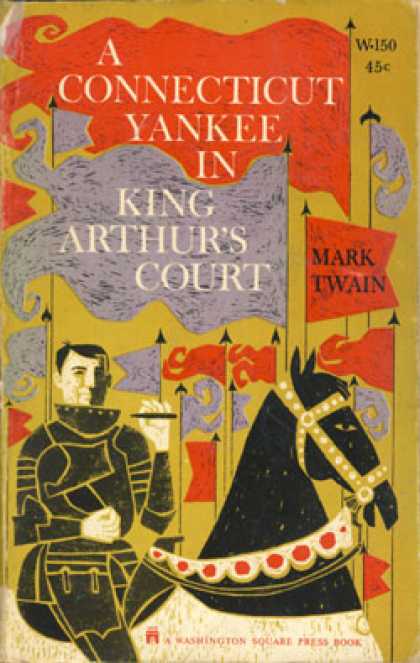 Though there are other cases of extreme violence in Mark Twain’s novels, two instances of graphic violence in A Connecticut Yankee in King Arthur’s Court. Violent episodes such as Huck Finn and Jim stumbling upon a body in house that is later revealed to be Pap and the Grangerford episode from Adventures in Huckleberry Finn stick out in my mind the most, but they still do not register against the violence that Hank Morgan sees during his time in King Arthur’s Court.
Though there are other cases of extreme violence in Mark Twain’s novels, two instances of graphic violence in A Connecticut Yankee in King Arthur’s Court. Violent episodes such as Huck Finn and Jim stumbling upon a body in house that is later revealed to be Pap and the Grangerford episode from Adventures in Huckleberry Finn stick out in my mind the most, but they still do not register against the violence that Hank Morgan sees during his time in King Arthur’s Court.The first of these episodes that I found the most violent or disturbing was when Queen Morgan le Fay effortlessly “slipped a dirk into [her page] in as-matter-of-course a way as another person would have harpooned a rat” (102) after he accidentally bumps into her. Nobody dares to do or say anything and the Queen, as if killing a boy is like spilling a little milk, instructs her servants exactly how to clean up the mess. Later in the chapter when the boy’s grandmother arrives cursing the queen, again her only reaction is to get rid of the nuisance, presumably by tying her to a stake.
The second scene that felt very violent and almost like it does not fit in with the rest of the novel are the “smileless” pilgrims, who are in fact slaves in chains being marched along the same road towards the Valley of Holiness. Hank’s description of their “sores which were ulcerated and wormy” (139) and situation that he witnesses where a young mother is first hit and then held down by other slaves while she is beaten, only to later be separated from her husband after being sold to a blacksmith. Hank “wanted to stop the whole thing and set the slaves free, but that would not do” (141), so instead he just watches the entire episode along with the other pilgrims, even though he obviously affected by the scene and says “I knew I should never get [this] picture out of my mind again, and there it is to this day, to wring my heartstrings whenever I think of it” (141).
Part of the reason these two episodes are powerful is the narrator’s response to the situations. In previous novels, frequently characters seem coolly unconcerned by violence, in Puddn’head Wilson dueling is an acceptable sport for men and women to watch and in Adventures of Huckleberry Finn, many violent scenes that young Huck encounters are only briefly mentioned in passing. Even in A Connecticut Yankee, other characters in the novel are not as affected by these violent events as Hank Morgan is. Hank notes that after the slave girl is beaten and the other pilgrims on the road just watch, “this is what slavery will do, in the way of ossifying what one may call the superior lobe of human feeling” (141). These scenes I think are powerful and dramatic not only because they illustrate inhumane conditions, desolation, and pain, but also because Twain reworks themes like cruelty and brutality and sets them in a new time period making the situations more objective. Mark Twain is setting events such as a slave beating in a more exotic setting for dramatic effect in order to outline some of his personal beliefs.
After reading this section of the book I found an article by Henry Nash Smith that was helpful in pulling a lot of these ideas together for me. In his article “Pudd’nhead Wilson and After,”* Nash takes a look at Twain’s work and chronological order and highlights a pattern that appears beginning with A Connecticut Yankee in King Arthur’s Court. Nash also focuses on the scene where Queen Morgan le Fay stabs the young page who “fell lightly against her knee” (Twain 102) as well as the story of the husband being tortured on the rack. Nash claims that after these episodes there is “a paragraph curiously out of tone with the immediate context and with the book as a whole” (234). The reason for this is because “it contains the gist of Mark Twain’s ‘gospel’ the philosophical treatise called What Is Man?” (235) and focuses on Twain’s theme of training in this novel, and in others. Both scenes that I mentioned earlier fall into this category of training, what Nash defines as “the shaping of the personality by society,” which makes the institutions of the feudal system and slavery acceptable. I agree with Nash that some of Hank Morgan’s statements and opinions in the book are a little out of place but I think, like “Puddn’head Wilson’s Calendar” quotations, I see it as Mark Twain folding in some of his own views on the world with a work of fiction.
*Smith, Henry Nash. “Puddn’head Wilson and After.” The Massachusetts Review 3.2 (1962): 233-253.

No comments:
Post a Comment